It was in the early 1960’s that everything started for Ferme Jean-Paul Petitclerc & Fils inc., when Jean-Paul Petitclerc made the acquisition of a small piece of land with about fifteen cross bred cows, in Saint-Basile, Portneuf,
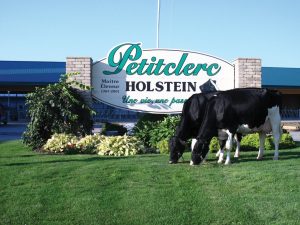 History
History
…about thirty minutes from Quebec City. In the 1970’s the family started working with pure bred animals. Each year the acquisition of quota, land and the upgrading of infrastructures have been made and now the Petitclerc Family is on it’s third generation of dairy farming.
The Enterprise in 2015
Today the herd consists of 300 head total, including 130 cows, 100 of which are milking and are producing 140 kilograms (kgs) of fat a day. Two time Master Breeder winner (1987 and 2001) and eligible again in 2014. The Petitclerc herd consists of 26 EX, 80 VG and 24 GP, with an average production of 11,500 kgs at 4.3% of fat and 3.3% of protein. The milk cows are kept in a tie-stall barn while the dry cows, pregnant heifers and young heifers are housed in a free stall barn with alley scrappers. The calves are in a nursery with separate pens. Recently a new barn was built to accommodate from 80 to 100 head including their top cows and heifers with the most genetic and show potential.
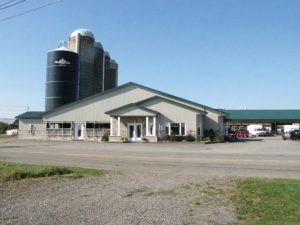 The farm consists of 350 acres of land, from which 50 acres are used for corn and the rest for hay. In general they buy most of their corn and a bit of hay, depending on the years productivity. The acquisition of more land is a short term project so long term they are able to plant more every year. Each year they look at different field options to be able to expand their crops but according to Réjean, “it’s really not that simple,” they have to keep a sharp eye open to be sure not to miss the opportunity of expanding.
The farm consists of 350 acres of land, from which 50 acres are used for corn and the rest for hay. In general they buy most of their corn and a bit of hay, depending on the years productivity. The acquisition of more land is a short term project so long term they are able to plant more every year. Each year they look at different field options to be able to expand their crops but according to Réjean, “it’s really not that simple,” they have to keep a sharp eye open to be sure not to miss the opportunity of expanding.
 At Petitclerc it really is a family affair considering that Réjean and his wife, Carole and their three kids, are fully committed to the farm. Réjean takes care of herd management and helps out with the milking and the crops. Carole also helps out with the morning milking, as well as taking care of the farm accounting and landscaping around the yard. Their two boys, Maxime (28) and Dominic (24), also work full time on the farm. Maxime dedicates most of his time to the looking after the cows as well as crops and of course the shows. For his part, Dominic manages the heifers and calves feeding program and he dedicates most of his time getting them ready for big shows. Mélanie (26), is a teacher at an elementary school but also works part time helping out with the registration of the animals. Even though they all work hard on their family farm, they still have one part time employees who mostly take care of the daily chores and every year they have a summer employee to help out during the busiest parts of the summer.
At Petitclerc it really is a family affair considering that Réjean and his wife, Carole and their three kids, are fully committed to the farm. Réjean takes care of herd management and helps out with the milking and the crops. Carole also helps out with the morning milking, as well as taking care of the farm accounting and landscaping around the yard. Their two boys, Maxime (28) and Dominic (24), also work full time on the farm. Maxime dedicates most of his time to the looking after the cows as well as crops and of course the shows. For his part, Dominic manages the heifers and calves feeding program and he dedicates most of his time getting them ready for big shows. Mélanie (26), is a teacher at an elementary school but also works part time helping out with the registration of the animals. Even though they all work hard on their family farm, they still have one part time employees who mostly take care of the daily chores and every year they have a summer employee to help out during the busiest parts of the summer.
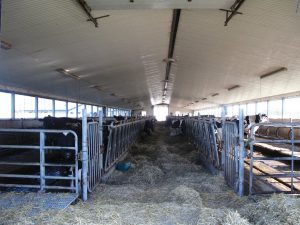 Feeding
Feeding
The milk cows get fed a Total Mixed Ration (TMR) that is comprised of 40% corn silage and 60% alfalfa, with two kinds of personalized mixed supplements, mineral, soda and high moisture corn. The cows are separated into two groups, one of high producing cows and the other, end of lactation cows. The dry cows, for their part, are fed first cut wrapped round bales with a small amount of mineral. Although, during winter, they add corn silage to their daily meal plan. Finally the dry cows are kept, from the springtime to fall, out on pasture. The bred heifers, until they calve, get 6 kgs of hay silage with first cut hay at 13-14% protein and mineral. The 6-12 month heifers are kept on supplement with cubed grain and are also fed first cut hay with 13-14% protein. For the calves, from birth until weaning at six weeks, they consume powdered milk gradually until they hit 8L a day, with a little bit of calf grain and water.
 Show life
Show life
“The shows are a great way for us to enforce our genetics, to show our vision of breeding,” Réjean says with sincerity. Shows are also great places to see which bulls are the most up and coming of the breed. “We get to see the heifers and the cows up close and personal. We get a visual of what we really appreciate and maybe what we appreciate less,” says Maxime. It is also an opportunity to compare their show cattle to other great breeders who share the same passion for the industry as they do and to also learn more and stay on top of what is happening in the Holstein world. At the Petitclerc Farm, the entire family loves to surpass themselves and work with beautiful and great cows. It is this reason that the genetics and the shows are the heart of the herd.
 Petitclerc has been showing since 1967 and exhibiting at approximately eight shows either locally, regionally, provincially and even nationally and internationally. At each and every one of these shows, Petitclerc makes its mark by winning many prizes and banners. In the end, their greatest pride is showing as many cows and heifers with the PETITCLERC prefix as possible. Recently the Petitclerc herd exhibited twelve heifers at the World Dairy Expo. Ten of which made the top 10, each in their own respective classes, including Petitclerc Windbrook Anaconda who took home the prize for first summer yearling. On top of all that, the Petitclerc’s won the Junior Breeder’s Herd and the banners for Junior Exhibitor and Breeder.
Petitclerc has been showing since 1967 and exhibiting at approximately eight shows either locally, regionally, provincially and even nationally and internationally. At each and every one of these shows, Petitclerc makes its mark by winning many prizes and banners. In the end, their greatest pride is showing as many cows and heifers with the PETITCLERC prefix as possible. Recently the Petitclerc herd exhibited twelve heifers at the World Dairy Expo. Ten of which made the top 10, each in their own respective classes, including Petitclerc Windbrook Anaconda who took home the prize for first summer yearling. On top of all that, the Petitclerc’s won the Junior Breeder’s Herd and the banners for Junior Exhibitor and Breeder.
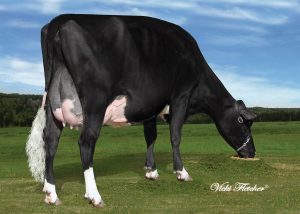 With time, the Brabantdale Jasper Spades VG-88 8* and Petitclerc Storm Amy EX-92 2E 15* families have been exploited and are, to this day, used to their full potential to breed exceptional show cattle. Among Amy’s grand-daughters, Petitclerc Goldwyn Anouk VG-89 2YR, left her mark in the show ring by winning the titles of Reserve All-Canadian in 2014 and Honourable Mention All-Canadian in 2013. In Brabantdale Jasper Spades’ family, we can find many daughters like Petitclerc Gold Saltalamacchia VG-89 2YR. Saltalamacchia, the 1st Milking Yearling and Best Udder at the Royal and Unanimous All-Canadian in 2014, was 1st Senior Calf and Honourable Mention Junior Champion at the World Dairy Expo in 2013 as well as being Reserve All-American.
With time, the Brabantdale Jasper Spades VG-88 8* and Petitclerc Storm Amy EX-92 2E 15* families have been exploited and are, to this day, used to their full potential to breed exceptional show cattle. Among Amy’s grand-daughters, Petitclerc Goldwyn Anouk VG-89 2YR, left her mark in the show ring by winning the titles of Reserve All-Canadian in 2014 and Honourable Mention All-Canadian in 2013. In Brabantdale Jasper Spades’ family, we can find many daughters like Petitclerc Gold Saltalamacchia VG-89 2YR. Saltalamacchia, the 1st Milking Yearling and Best Udder at the Royal and Unanimous All-Canadian in 2014, was 1st Senior Calf and Honourable Mention Junior Champion at the World Dairy Expo in 2013 as well as being Reserve All-American.
 Spades’ grand-daughter by Sid, Petitclerc Sid Sunkiss EX-92, now owned by Budjon Farms and Peter & Lyn Vail, WI., was crowned Reserve All-Canadian and Reserve All-American in 2013 and most recently, she was 2nd at the World Dairy Expo and a member of Petitclerc’s 3rd place Senior Breeder’s Herd. She also won the title of Reserve Grand Champion at the Wisconsin Championship Show. Sunkiss’ full sister, Petitclerc Sid Snowflake VG-89, owned by Milksource Genetics, WI., was 1st Junior 2-Year-Old and Honourable Mention Intermediate Champion at the Wisconsin Championship Show. These two families continue to produce heifers and cows for shows with the refinement, angularity, balance and style important for success in the show ring.
Spades’ grand-daughter by Sid, Petitclerc Sid Sunkiss EX-92, now owned by Budjon Farms and Peter & Lyn Vail, WI., was crowned Reserve All-Canadian and Reserve All-American in 2013 and most recently, she was 2nd at the World Dairy Expo and a member of Petitclerc’s 3rd place Senior Breeder’s Herd. She also won the title of Reserve Grand Champion at the Wisconsin Championship Show. Sunkiss’ full sister, Petitclerc Sid Snowflake VG-89, owned by Milksource Genetics, WI., was 1st Junior 2-Year-Old and Honourable Mention Intermediate Champion at the Wisconsin Championship Show. These two families continue to produce heifers and cows for shows with the refinement, angularity, balance and style important for success in the show ring.
Since 2008
–20 All-American Nominations
-2 All-Americans
-6 Reserves
-5 Honourable Mentions
–30 All-Canadian Nominations
-6 All-Canadians
-6 Reserves
-6 Honourable Mentions
Maintaining his passion for showing, Réjean loves giving his opinion in the show ring and has been an official judge for 20 years. Judging shows in Quebec as well as in France, in 2014 he was the official judge for the Holstein show at the Supreme Laitier and the Junior Classic Quebec Show, in Montmagny, last August.
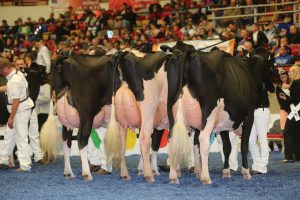 Ultimately, genetics and shows are very important for the Petitclerc family, but they maintain they do not want to shy away from the basics. The first and for most goal of the company, like any other dairy farm, is to produce milk to pay the bills. The shows are a big priority, but the production is not left aside. “Without the production, there is no show”, adds Réjean.
Ultimately, genetics and shows are very important for the Petitclerc family, but they maintain they do not want to shy away from the basics. The first and for most goal of the company, like any other dairy farm, is to produce milk to pay the bills. The shows are a big priority, but the production is not left aside. “Without the production, there is no show”, adds Réjean.
Most important Sale in the last 5 years
-Petitclerc Sid Sunkiss EX-92 (MS : 94) to Budjon Farms, Peter & Lyn Vail, WI
-Petitclerc Sid Snowflake VG-89 2YR, Milksource, WI
-Petitclerc Goldwyn Alcatraz VG-87 2YR, Westcoast Holsteins, BC
-Petitclerc Goldchip Skydome VG-88 2YR, Budjon Farms, WI
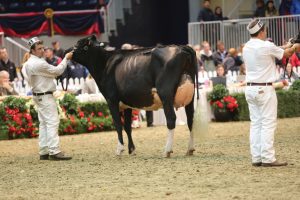 The ultimate goal for the Petitclerc family is to raise the best cow possible, to always aim higher and set achievable goals. For them it is a necessity to keep getting better. “It is no longer the biggest cow that wins at shows,” says Réjean. For many years, the standards have changed, the Holstein breed has changed. “We want functional cows and it is not the cow with the biggest udder that makes the most milk,” reminds Réjean. In the future, Maxime and Réjean have hopes the calving age will get closer to 22 to 24 months.
The ultimate goal for the Petitclerc family is to raise the best cow possible, to always aim higher and set achievable goals. For them it is a necessity to keep getting better. “It is no longer the biggest cow that wins at shows,” says Réjean. For many years, the standards have changed, the Holstein breed has changed. “We want functional cows and it is not the cow with the biggest udder that makes the most milk,” reminds Réjean. In the future, Maxime and Réjean have hopes the calving age will get closer to 22 to 24 months.
Réjean sees genomics as a work tool that provides extra information. In their herd, they genomic test only a few. “We believe genomics is growing and developing so quickly and there is too much money involved to realistically develop and master the use of it in our herd. Even though we are not going the genomic route we still stay up to date with what is happening, it’s like shows, only a small percentage perform to the maximum. They are always ups and downs,” adds Réjean.
 In regard to the use of bulls, during breedings and/or for embryo transfers, Petitclerc’s use mostly proven bulls compared to a small amount (about 15%) of genomic bulls. In these special cases they use genomic bulls out of well known cow families. All the matings are made specifically for the shows. Right now, they are using DOORMAN, SID, ARCHRIVAL, DEMPSEY, GOLDCHIP, GOLDEN DREAMS, SOLOMON, MCCUTCHEN and GOLDWYN. Inbreeding does not worry them. They do not want to stray away from GOLDWYN since he is the most renowned bull in the show ring. They do hope that some new bloodlines will appear on proof sheets soon as they will not be able to keep using out of the GOLDWYN family. Réjean and Maxime really watch what is happening in other countries to inspire them to breed good heifers and great show cows. What they look for in bulls is the proof they made their mark. Seeing daughters at the shows as well as in the barn is equally important. Feet and legs and mammary systems are the most important for them but they also look for longevity and balance in their breeding and in the purchase of animals.
In regard to the use of bulls, during breedings and/or for embryo transfers, Petitclerc’s use mostly proven bulls compared to a small amount (about 15%) of genomic bulls. In these special cases they use genomic bulls out of well known cow families. All the matings are made specifically for the shows. Right now, they are using DOORMAN, SID, ARCHRIVAL, DEMPSEY, GOLDCHIP, GOLDEN DREAMS, SOLOMON, MCCUTCHEN and GOLDWYN. Inbreeding does not worry them. They do not want to stray away from GOLDWYN since he is the most renowned bull in the show ring. They do hope that some new bloodlines will appear on proof sheets soon as they will not be able to keep using out of the GOLDWYN family. Réjean and Maxime really watch what is happening in other countries to inspire them to breed good heifers and great show cows. What they look for in bulls is the proof they made their mark. Seeing daughters at the shows as well as in the barn is equally important. Feet and legs and mammary systems are the most important for them but they also look for longevity and balance in their breeding and in the purchase of animals.
When they purchase a new animal for their herd, they prefer to invest in a young cow so they can develop and utilize her to her full potential. First and foremost, the Petitclerc’s put huge importance on the udder quality on a cow and feel it proves their quality and provides no surprises. When they made the acquisition of Brabantdale Jasper Spades as a heifer, they trusted that cow family and with time, she became a major brood cow of the herd.
Latest acquisitions
Massico Windbrook Charly VG-89, 12 generations VG or EX, with 70*
Pierstein Windbrook Tibout VG-86 2YR, 10 generations EX
Robella Goldwyn Edgeley VG-88, 5 generation VG or EX
Blondin Affirmed Satine VG-89 3YR, 9 generations VG or EX, with 62* (Supra’s Family)
Ricagri Dempsey Pace NC, 1st Milking Yearling at Quebec Provincial Show
The Petitclerc herd is sought out by sale managers regularly for consignments. Réjean admits it is important to participate to show that their herd is accessible and to bring new selling opportunities. “We like to support more local sales,” says Réjean. Maxime also likes selling outside the province, “the sales in the United States and in Ontario for example, are different. They have their positive points, we win by visiting those sales and by participating.” They cannot send animals everywhere, but a selection is made and every option is evaluated to the fullest sale potential.
Petitclerc is actively involved in the embryo market and perform between 25 and 30 flushes every year. As often as possible they use the conventional method, doing in-vitro fertilization occasionally. 30% of the cows in the herd carry embryos, allowing them to expand their best families and use sexed embryos more and more. In total, about 20 to 25% of their embryos are sold abroad to countries like the United Kingdom, France, Switzerland, Italy, Australia and Brazil. To be able to sell abroad, “you have to stay with the times,” says Réjean. “We also have to listen to the clients’ needs and be aware of what is going on in the market,” adds Maxime. Both agree that participating in shows and accumulating good results helps them to finalize international deals. Pictures taken at shows and visitors to the shows and the farm is what starts people talking about their herd. “Now, with the new technology like internet and social media, it is easy and fast to obtain news regarding shows in other countries. We can even watch live broadcasts of shows in Switzerland,” mentions Réjean.
Having summer interns from around the world every year brings business opportunities as well. Participating in shows is an occasion to be recognized and to be talked about in other countries. One way or another, it is a fast and effective way to do some marketing. “This summer, we had a girl from Austria and right now we have to boys from Italy,” Maxime specifies. So, visitors are always welcome at Ferme Jean-Paul Petitclerc & Fils.
A new barn to give more comfort and increase the number of young stock, a project which began in July of this year, is finally finished and highlights the continued passion and drive towards the future for the Petitclerc family. The family works hard daily towards the goal of obtaining a third Master Breeder title. Long term, the transfer of the enterprise will insure the continued success of Petitclerc Holsteins.
By Josiane Chabot, QC
UN PEU D’HISTOIRE
C’est au début des années 1960 que tout a commencé pour la Ferme Jean-Paul Petitclerc & Fils inc., lorsque Monsieur Jean-Paul Petitclerc fait l’achat d’un petit lopin de terre à Saint-Basile, dans le compté de Portneuf, à environ trente minutes de Québec, et d’une quinzaine de vaches croisées. C’est seulement en 1970 que les Petitclerc commencent à travailler avec des animaux pur sang. Depuis ce temps, l’achat de quota, de terres et l’amélioration des infrastructures se font graduellement chaque année. La famille Petitclerc en est à sa troisième génération sur l’exploitation laitière.
L’ENTREPRISE EN 2015
À ce jour, l’entreprise compte 300 têtes au total, avec 130 vaches, dont 100 vaches en lait pour 140 kg/jour. Le troupeau Petitclerc, deux fois Maître-Éleveur en 1987 et en 2001 et à nouveau admissible pour 2014, comporte 26 EX, 80 TB et 24 BP, avec une moyenne de production de 11 500 kg, à 4,3 % de gras et 3,3 % de protéine. Il s’agit d’une installation à stabulation entravée pour les vaches en lait. Les vaches taries et les taures gestantes, ainsi que les génisses, sont en stabulation libre avec raclette. Les veaux sont dans une pouponnière avec parcs séparés. Depuis peu, une nouvelle étable a été construite pouvant accueillir de 80 à 100 animaux. Ils y gardent les vaches et les génisses avec le meilleur potentiel génétique ainsi que ceux qui font de l’exposition.
L’exploitation s’étend sur 350 acres de terre, dont 50 acres de maïs et le reste en foin. Ils font donc l’achat de maïs grain et d’un peu de foin, selon le rendement de l’année. De plus, c’est un projet à court, moyen et long terme d’acquérir plus de terres, afin de cultiver davantage. Chaque année, ils regardent les options d’achat de terres chez un voisin, mais selon Réjean, ce n’est vraiment pas évident, il faut tout de même garder l’œil ouvert.
À la Ferme Petitclerc, il s’agit d’une affaire de famille, puisque Réjean et Carole s’investissent à temps plein dans l’entreprise. Réjean s’occupe de toute la régie du troupeau ainsi que des traites et apporte du sien lors des récoltes. Pour sa part, Carole fait la traite, toute la comptabilité et l’aménagement paysager. Leurs deux garçons, Maxime, 28 ans et Dominic, 25 ans, travaillent également à temps plein au sein de l’entreprise. Maxime consacre une grande partie de son temps à l’alimentation des vaches, aux semences et récoltes, mais également à l’exposition. Dominic, de son côté, gère l’alimentation des génisses et des veaux et consacre la majorité de son temps à préparer ceux-ci pour les expositions. Mélanie, 26 ans, est enseignante au primaire, mais donne aussi de son temps à l’entreprise, en s’occupant d’enregistrer les animaux. La famille Petitclerc a deux employés à temps partiel qui effectuent la plupart des tâches quotidiennes et un ou une stagiaire pendant l’été pour apporter du soutien dans les périodes les plus occupées.
L’ALIMENTATION
En ce qui concerne l’alimentation, les vaches en lait sont à la ration totale mélangée qui est composée à 40 % de maïs ensilage et de 60 % de luzerne, avec deux sortes de supplément personnalisé, du minéral, du soda et du maïs humide. Les vaches sont séparées en deux groupes, celui des fortes productrices et celui des fins de lactation. Les vaches taries, elles, ont de la balle de foin enrobée de première coupe avec un peu de minéral seulement. L’hiver, on ajoute à leur alimentation, du maïs humide. Du printemps à l’automne, les vaches taries sont au pacage. Les taures saillies jusqu’au vêlage ont 6 kg d’ensilage de foin avec du foin de première coupe à 13-14 % de protéine et du minéral. Les génisses de six à douze mois ont du supplément avec de la moulée cubée ainsi que du foin de première coupe à 10-11 % de protéine. Les génisses de deux à six mois ont de la moulée cubée avec du foin de première coupe également de 13-14 % de protéine. Pour ce qui est des veaux, de la naissance jusqu’au sevrage à six semaines, ils consomment du lait en poudre, quantité graduelle pour atteindre 8L/jour, avec un peu de moulée et d’eau.
L’EXPOSITION
« L’exposition est l’endroit idéal pour nous de faire valoir notre génétique, de montrer notre vision de l’élevage », mentionne, avec sincérité, Réjean. L’exposition est aussi un excellent endroit pour voir les taureaux qui sont en vigueur. « Nous pouvons voir les génisses et les vaches en vrai. Nous avons un visuel de ce que nous apprécions et de ce que nous apprécions le moins », dit Maxime. C’est aussi l’occasion de comparer leur élevage avec celui des autres éleveurs qui ont la même passion qu’eux et ainsi se faire connaître davantage et de rester à l’affût de ce qui se passe dans l’industrie de la Holstein. À la Ferme Petitclerc, toute la famille aime se surpasser et travailler avec de belles vaches. C’est principalement pour cette raison que la génétique et l’exposition sont au cœur du troupeau.
La Ferme Petitclerc est présente chaque année depuis 1967 à plus ou moins huit expositions par année, autant locales, régionales, provinciales, nationales qu’internationales. À chacune de celles-ci, le troupeau Petitclerc fait sa marque en remportant plusieurs prix et bannières. D’ailleurs, l’une de leurs plus grandes fiertés est probablement d’exposer autant des vaches que des génisses, sans cesse sous le préfixe PETITCLERC. Récemment, le troupeau Petitclerc a exposé douze génisses à la Wold Dairy Expo et dix d’entre elles ont terminé dans le top 10 de chacune de leur classe respective. Petitclerc Windbrook Anaconda a remporté la première position dans la classe de Génisse 1 an Été. Le troupeau Petitclerc a également obtenu le premier Troupeau d’Éleveur Junior et les bannières d’Exposant et d’Éleveur Junior. Avec le temps, les familles de Brabantdale Jasper Spades TB-88 8* et Petitclerc Storm Amy EX-92 2E 15* ont été exploitées et le sont encore pour ainsi faire des animaux d’exposition. Parmi les petites-filles d’Amy, il y a Petitclerc Goldwyn Anouk TB-89 2 ans qui a laissé sa marque dans les arènes d’expositions en remportant les titres d’All-Canadian de Réserve en 2014 et de Mention-Honorable All-Canadian en 2013. Dans la famille de Spades, il y a sa fille par Goldwyn, Saltalamacchia, qui a été nommée All-Canadian unanime 1 an Senior en lait en 2014, en étant 1re et meilleur pis à la Royal de Toronto. Elle qui a également été 1re génisse Senior et Mention-Honorable Junior à la World Dairy Expo 2013, en plus d’obtenir le titre d’All-American de Réserve cette même année. Il y a aussi sa petite-fille par Sid, Sunkiss, maintenant la propriété de Budjon Farms, Peter & Lyn Vail, WI, qui a été couronnée All-Canadian de Réserve et All-American de Réserve en 2013. Dernièrement, elle a terminé 2e à la World Dairy Expo en plus de faire partie du 3e troupeau d’éleveur Senior du préfixe Petitclerc. Elle a eu le titre de Championne de Réserve au Wisconsin Championship Show et 1re 4 ans. Également, une sœur propre de Sunkiss, Snowflake, propriété de Milksource, WI, a terminé 1re 2 ans Junior et Mention-Honorable Intermédiaire au Wisconsin Championship Show. Avec ces deux familles, on trouve des génisses et des vaches naturelles pour l’exposition avec du raffinement, de l’angularité et du style. Ce sont tous des critères très importants pour performer lors d’un jugement.
Depuis 2008,
20 Nominations All-American
– 2 All-American
– 6 Réserves
– 5 Mention-Honorables
30 Nominations All-Canadian
– 6 All-Canadian
– 6 Réserves
– 6 Mention-Honorables
Entretenant sa passion pour les expositions, Réjean aime bien donner son opinion dans une arène d’exposition. C’est pourquoi il est juge officiel depuis maintenant 20 ans. Il a eu l’occasion de juger la plupart des expositions au Québec et il a aussi jugé en France. Plus récemment, il a officialisé le Suprême Laitier, à Saint-Hyacinthe en novembre 2014 et la Classique des Jeunes Ruraux Québécois, à Montmagny en août dernier.
En fin de compte, la génétique et l’exposition sont très importantes pour les Petitclerc, mais ils ne veulent tout de même pas s’éloigner de la base, le but premier de ‘entreprise : du lait pour payer les factures. Les expositions sont priorisées, mais la production n’est pas mise de côté pour autant. « Sans la production, il n’y a pas d’exposition », ajoute Réjean.
Ventes les plus importantes depuis 5 ans,
– Petitclerc Sid Sunkiss EX-92 (SM:94), Budjon Farms, Peter & Lyn Vail, WI
– Petitclerc Sid Snowflake TB-88 2ans, Milksource, WI
– Petitclerc Goldwyn Alcatraz TB-87 2 ans, Westcoast Holsteins, BC
Le but ultime pour la famille Petitclerc est d’élever la meilleure vache possible, de toujours viser plus haut et de se fixer des objectifs réalisables. Pour elle, il est nécessaire de sans cesse s’améliorer. « Ce n’est plus la plus grosse vache qui gagne à l’exposition », évoque Réjean. Depuis quelques années, les critères ont changé, la race Holstein a évolué. « Nous voulons des vaches fonctionnelles et ce n’est pas les vaches avec les plus gros pis qui font le plus de lait », rappelle Réjean. De plus en plus, Réjean et Maxime espèrent que l’âge au vêlage s’approche des 22 ou 23 mois.
Réjean Petitclerc voit davantage la génomique comme un outil de travail, un surplus de données. Dans leur troupeau, ils utilisent très peu le test de la génomique. Selon eux, ce domaine va trop vite et trop d’argent est en jeu pour l’exploiter adéquatement au sein de leur élevage. Ils ne maîtrisent pas assez l’outil pour l’utiliser à son maximum. « Nous nous tenons tout de même au courant de ce qui se passe, c’est comme à l’exposition, seulement un faible pourcentage performe au maximum et même qu’il y a des hauts des bas », ajoute Réjean.
Pour ce qui est de l’utilisation des taureaux, lors de saillies ou de transplantations, ils utilisent majoritairement des taureaux éprouvés et que très peu de taureaux génomiques (environ 15 %) et si c’est le cas, ils proviennent de familles connues. Ils n’utilisent aucunement les jeunes taureaux. Tous les vêlages et les croisements sont réalisés en fonction des expositions. En ce moment, ils utilisent DOORMAN, SID, ARCHRIVAL, DEMPSEY, GOLDCHIP, GOLDEN DREAMS, SOLOMON et encore GOLDWYN. La consanguinité ne les inquiète pas. Ils ne veulent pas trop s’éloigner de GOLDWYN, puisque c’est le taureau le plus renommé dans les arènes d’exposition. Ils espèrent que de nouveaux taureaux arriveront bientôt sur les feuilles d’épreuves, car c’est la troisième génération qui s’en vient qui sera plus inquiétante. Ils ne pourront plus utiliser la famille de Goldwyn. Réjean et Maxime regardent beaucoup ce qui se fait dans les autres pays pour s’inspirer des croisements qui s’y font afin de faire de belles génisses et de belles vaches d’exposition. Ils recherchent des taureaux de confiance qui ont fait leurs preuves, c’est pourquoi selon eux, c’est important de voir des filles autant à l’exposition qu’en visitant d’autres troupeaux. Les pieds et membres ainsi que les systèmes mammaires sont les critères les plus importants pour eux. Ils recherchent aussi la longévité et le balancement, autant dans leurs croisements que lors d’achats d’animaux.
Lorsqu’ils font l’acquisition d’un nouvel animal dans leur troupeau, ils préfèrent investir dans une jeune vache, afin de développer son potentiel et de l’exploiter au maximum. D’abord et avant tout, les Petitclerc accordent une grande importance à la qualité du pis chez une vache. Il s’agit pour eux d’une valeur sûre; de cette façon, ils n’ont pas de surprise. Quand ils ont fait l’acquisition de Spades, ils avaient confiance en cette famille et cette vache leur a amené l’une des familles souches du troupeau à ce jour.
Les quelques dernières acquisitions,
Massico Windbrook Charly TB-89, de la famille de Chalou
Pierstein Windbrook Tibout TB-86 2ans, fille de Pineland Goldwyn Tidbit EX-91
Robella Goldwyn Edgeley TB-88, fille de Robella Dundee Eden EX 1*
Ricagri Dempsey Pace NC, 1ère 1 an Senior en Lait Expo Provinciale du Québec
Le troupeau Petitclerc est très sollicité lorsque les gérants de ventes font leur tournée de consignations. Réjean rappelle qu’il faut y participer pour montrer que leur élevage est accessible, il faut aussi participer pour amener d’autres occasions de vente. « Nous aimons encourager les ventes qui sont plus locales », ajoute Réjean. Maxime pour sa part évoque l’idée qu’on apprend de l’extérieur, « les ventes aux États-Unis et en Ontario par exemple sont différentes, elles ont leurs points positifs, on gagne à aller les voir et y participer ». Ils ne peuvent pas envoyer des bêtes partout, mais une sélection est faite et chaque demande est étudiée.
Les Petitclerc sont très ouverts au marché des embryons. D’ailleurs, ils effectuent entre 25 et 30 récoltes embryonnaires chaque année. Le plus souvent possible, c’est de la façon traditionnelle; ils font rarement de la transplantation in vitro. Au sein du troupeau, c’est 30 % des vaches qui portent des embryons. De cette façon, ils exploitent le plus possible leurs meilleures familles et sexent de plus en plus aussi. C’est environ 20 à 25 % du total des embryons qui est vendu majoritairement à l’étranger (Royaume-Uni, France, Suisse, Italie, Australie et Brésil). Pour vendre ailleurs dans le monde, « il faut être à la mode », dit Réjean. « Il faut également écouter les besoins des clients et être à l’affût de ce qui se passe sur le marché », ajoute Maxime. Le père et le fils s’entendent pour dire que faire de l’exposition et accumuler de bons résultats leur permet de faire ces ventes internationales. C’est avec les photos prises aux expositions et avec les visiteurs que l’on fait parler de notre élevage. « Maintenant, avec la technologie, Internet et les réseaux sociaux, c’est facile et rapide d’avoir des nouvelles d’une exposition dans un autre pays, nous pouvons même voir en direct un jugement qui se passe en Suisse », mentionne Réjean.
Probablement que le fait d’avoir des stagiaires, chaque année provenant d’ailleurs dans le monde amène des opportunités d’affaires. Faire de l’exposition donne l’occasion de se faire connaître et de faire parler de nous dans les autres pays. D’une façon ou d’une autre, c’est aussi une façon de faire du marketing rapidement et efficacement. « Dernièrement, nous avons eu une fille de l’Autriche et présentement, nous avons deux garçons de l’Italie », précise Maxime. Ils sont très heureux de recevoir des visiteurs en tout temps à la Ferme Jean-Paul Petitclerc & Fils.
Le projet d’une nouvelle étable, afin de donner plus de confort et d’augmenter le cheptel de génisses est enfin réalisé, un projet qui a débuté en juillet et qui a pris fin début septembre. Quotidiennement, la famille travaille dans le but d’obtenir un troisième titre de Maître-Éleveur. Dans les projets à long terme, il est certain que le transfert de l’entreprise est présent, mais il est encore tôt, selon Carole et Réjean.
